- Author Rachel Wainwright [email protected].
- Public 2023-12-15 07:39.
- Last modified 2025-11-02 20:14.
Intrauterine fetal development

Intrauterine development of the fetus lasts an average of 280 days from the moment of conception to the birth of a child (10 lunar or obstetric months or 40 weeks). It is customary to calculate the calculation from the first day of the last menstruation, from the moment the ovum begins to form, the fertilization of which with a sperm will become the birth of a future baby.
Throughout the entire period of pregnancy, the most complex process of intrauterine development of the fetus takes place, the formation of a ready-for-birth child from a fertilized egg.
Intrauterine development of the fetus by week
Consider how a child is formed and developed from the moment of conception, while it is important that the first weeks of growth are the most significant for the viability of the embryo and its normal development. Intrauterine development of the fetus by week is as follows:
- 1 week - a woman often does not yet know about her pregnancy, but an important process has already begun, the fertilized egg moves along the fallopian tubes. A morula or embryo is formed, which by the seventh day begins to implant into the uterine cavity;
- Week 2 - the process of implantation of a zygote or ovum continues, it deepens into the falling shell and grafts, dissolving it, the process of feeding the embryo begins. There is an elongation and division into two parts of the primary intestine of the fetus, the process of formation of the heart and a network of large vessels begins, initially the heart looks like a tube. The fruit at this time looks like a very small raspberry;
- Week 3 - the embryo changes shape and grows, the nervous system is laid, the spinal cord and brain are formed. By the 19th day, the first blood cells are born, the heart tube makes the first contractions on the 20th day. The eye pits are formed, from which the baby's eyes are subsequently formed;
- 4 weeks - the length of the fetus is 0.1 mm, the brain grows, the rudiments of its five departments are laid, at the same time the rudiments of the lungs, liver, intestinal tract, kidneys, inner ear, and muscle tissues are laid. During this period of intrauterine development, limbs begin to form, they look like small buds on the sides of the embryo. Primary formation of the mouth and development of the eyes occurs;
- 5-8 weeks - the zygote enters the stage of an embryo, the size of a grain of sand (from 0.4-1.0 mm to 11 mm) and the embryo weighs about 13 by the end of the eighth week, the formation of the skeleton and limbs, feet and hands is underway take shape. The body is practically formed, there are all the main organs, and some of them, for example, the kidneys and liver, are already functioning, juice is produced in the stomach. The formation of the genitals begins, the head is equal to the length of the body and the rudiments of the eyes, nose, mouth are clearly visible on it;
- 8-12 weeks - from week 10 we can talk about intrauterine development of the fetus, since the fetal period has begun. The fetus weighs 13-14 g by the end of 12 weeks, and its length is about 9 cm. The placentation process is complete, the muscles begin to work, which by this time are already connected with nerve cells. The arms and legs are finally formed, the fetus develops a sense of balance, touch and smell. A septum has been formed that separates the abdominal cavity from the chest. The rudiments of milk teeth began to develop, the iris of the eyes is formed. The first signs of intestinal peristalsis appear, and the liver begins to produce bile;
- 13-16 weeks - the first trimester of pregnancy is over, ultrasound clearly shows the sex of the child, by the end of 16 weeks its height is 13-14 cm, and weight is 120-180 g. The skull is ossified, the facial features and the muscular system are finally formed. The female genital organs of future girls are being improved. The fetus actively moves the limbs, but the mother does not yet feel these movements due to its small size;
- 17-20 weeks - by the end of the fifth month, the weight of the fetus is 280-300 g, its length is already 18-19 cm. He already distinguishes sounds, and the movements become meaningful, hair, nails, eyelashes begin to grow. It is curious that by this time the child already tastes amniotic fluid and drinks it if he likes it, but stops drinking if it is bitter or sour. The sebaceous glands began to work, secreting a fatty substance that forms a cheese-like lubricant, mixing with the scales of the epidermis. Meconium begins to form in the intestines. From 18-20 weeks, the first movement of the fetus is noticeable and then the woman regularly feels its movements. During this period, the heartbeat is already heard and thanks to such listening, it is possible to determine whether there is a delay in the intrauterine development of the fetus;
- 21-24 weeks - by the end of the sixth month, the weight of the fetus is 600-700 g, its length is 25-30 cm. The formation of internal organs is complete, the fetus is able to produce respiratory movements, but it is not yet ready for extrauterine life. It is extremely rare for babies to survive at the end of 6 months of pregnancy;
- 25-28 weeks - the fetus continues to grow and gain weight, by the end of the seventh month the child's height is 30-35 cm, its weight is already 1.0-1.5 kg, but the cartilage tissue has not yet been fully formed, therefore the ear and nasal cartilage is still soft, and the nails do not completely cover the nail plates. The heart beats at a frequency of 120-130 beats / min, the fetal nervous system improves, the stage of fatty tissue accumulation and the final formation of the child's body begins. A fetus at 28 weeks is considered premature, but modern methods of care and timely assistance make the chances of survival for children born in the seventh month very high;
-

Features of intrauterine development of the fetus by week 29-32 weeks - weight 1.5-2.2 kg, height 40-45 cm, improved performance of internal organs, baby opens his eyes. It is already located head down and is born quite viable, further weight gain and growth is underway;
- 33-36 weeks - the intrauterine development of the fetus ends, it is less mobile, due to the lack of space for active movement. The baby's skin is smooth and pink, the cartilaginous tissue of the ears and nose becomes denser, the nail plates cover the nail holes and extend beyond the ends of the fingers. The formation of all internal organs has been completed, they are fully functioning;
- 37-40 weeks - the baby is full-term, all organs and systems are ready for autonomous functioning, the baby's movements are slowed down on the eve of birth. The baby's intestinal tract is filled with original feces, formed from everything that he swallowed during this time - skin scales, amniotic fluid, lanugo, defecation usually occurs after birth, but in some cases, under stress, part of the baby's intestines can be emptied into the amniotic fluid. Due to the increased level of estrogen, the mammary glands of girls and boys are enlarged, the swelling subsides in 2-3 weeks after birth.
With deviations at each stage, we can talk about a delay in the intrauterine development of the fetus, the causes of which can be both the mother's malnutrition and the pathology of the development of the organs of the unborn child. Timely detection and elimination of problems in the development of the fetus stabilizes its condition and normalizes further formation. That is why for any woman preparing to become a mother, constant monitoring and regular examination is important throughout the entire pregnancy.
Found a mistake in the text? Select it and press Ctrl + Enter.






